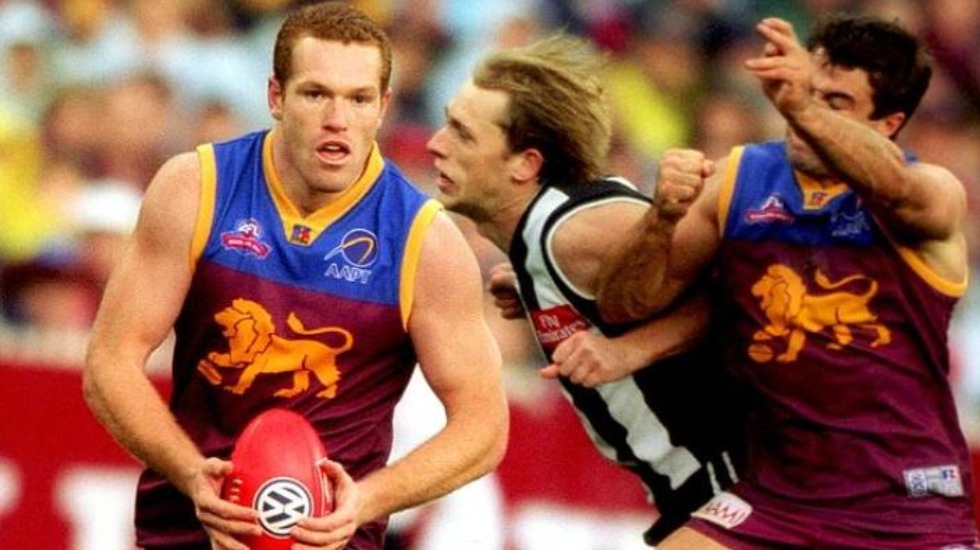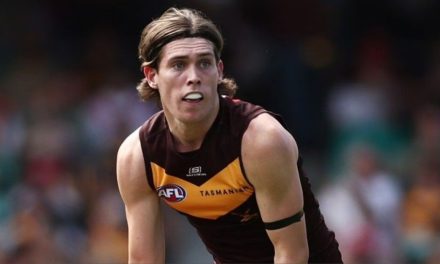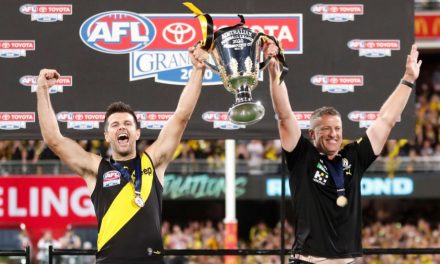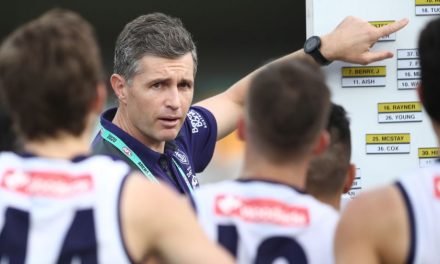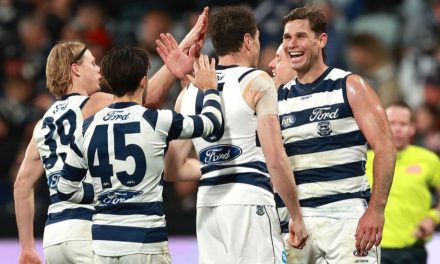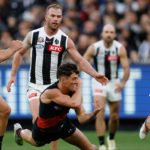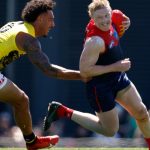Justin Leppitsch (left) won three All-Australian jumpers, a best-and-fairest and three flags with Brisbane. Photo: AFL MEDIA
Like the 1993 and 1997 Footyology Redrafts that have preceded it, the 1992 instalment turned out to be another massive building block for Brisbane’s future dynasty.
Three key members of the 2001-03 “three-peat” premierships not only made it into the revised top 10, but ended up in the top five.
Leading the pack is brilliant swing man Justin Leppitsch, who earns the title of the revised No.1 pick of the 1992 AFL Draft.
Originally selected at pick four, Leppitsch turned out to be one of the bedrocks of the Lions’ feared back six.
A strong centre-half back who meant business, Leppitsch was also capable in attack, as evidenced by his club leading goalkicker awards in 1997 and 1998 and his season tallies of 50 and 45 in 1996 and 1997 respectively.
However, he settled in defence in the second half of his career, and that’s where he truly made his name, taking on some of the game’s best forwards, and winning three All-Australian jumpers, a best-and-fairest and, of course, three flags in the process.
Hot on Leppitsch’s heels in second spot is another magnificent defender of his generation in Carlton’s Andrew McKay, who gets an 11-spot upgrade from No.13.
McKay was a mature recruit from Glenelg, and he hit the ground running as a 22-year-old in his first year with Carlton, earning All-Australian honours in 1993, and never looked back.
Two years after playing in a losing grand final in his debut season, McKay would taste the ultimate success, as the Blues smashed Geelong by 10 goals in the 1995 decider. The future veterinarian became part of one of the competition’s greatest ever teams which tasted defeat only twice the whole season.
McKay’s durability and dependability made him a permanent fixture in Carlton’s backline for a decade. His elite creativity, footy smarts, sound decision-making and excellent ball use saw him earn four All-Australian jumpers, a Blues best-and-fairest and induction into the South Australian Football Hall of Fame.
Coming in at No.3 is Martin Pike, the second of the aforementioned members of the champion Brisbane teams from the turn of the century.
PLEASE HELP US CONTINUE TO THRIVE BY BECOMING AN OFFICIAL FOOTYOLOGY PATRON. JUST CLICK THIS LINK.
But Pike made his way to Brisbane in a very roundabout way. He was first drafted by the Demons in 1992 with pick nine, was then shipped off to Fitzroy for its last two seasons of existence before making his way to North Melbourne where he featured in the Kangaroos’ 1999 premiership.
Then, a couple of seasons later, he finally wound up at Brisbane – as a Lion again, as fate would have it.
His five-year stint in Queensland was the crowning glory of his colourful career, winning three of his four premierships in five seasons, and joining Leppitsch as a key member of their tough and intimidating backline.
A damaging half-back flanker, he was also capable of playing a variety of roles, including drifting forward to have an impact on the scoreboard. Pike holds the honour of winning Fitzroy’s last ever best-and-fairest in 1996.
Rounding out the top five are dual premiership defender Damien Hardwick, who gets a massive upgrade from 87 to four, and the third member of the Brisbane premiership trifecta in Craig McRae, who was originally taken at pick 22 in the pre-season draft, which means he essentially gets promoted 141 spots in the pecking order – not a bad little bargain for the Bears/Lions.
Completing the revised top 10 is yet another big slider in Collingwood star Scott Burns, who moves up from No.90 to six, courageous key position player Leigh Colbert and the original 1992 No.1 pick and two-time West Coast premiership player Drew Banfield, who slides down to eight.
Darryl Wakelin and Shane Wakelin, the twin brothers who Pike famously said slept in bunk beds with the lights on, come in at nine and 10 respectively.
Darryl was another massive bargain, taken by Adelaide initially with pick 11 in the pre-season draft, the equivalent of pick 135 overall.
However, he would go on and make his name with St Kilda and Port Adelaide, playing a part in the Power’s one and only AFL flag in 2004.
Some players from the class of 1992 who can consider themselves unlucky to miss out on the revised top 10 are four-club spearhead Scott Cummings, Hawthorn key forward Nick Holland, North Melbourne cult hero Adrian McAdam, 200-gamer Jarrad Schofield, Essendon and Power goalsneak Che Cockatoo-Collins, Hawthorn sharpshooter John Barker and back-to-back Adelaide premiership player Kym Koster.
*Redrafts only consider the first time a player was drafted.


